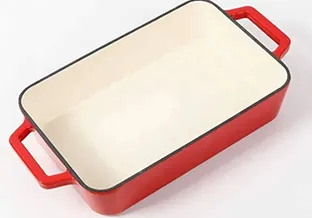
Exploring the Versatility and Benefits of Using a Dutch Oven for Cooking
The Dutch Oven A Kitchen Essential
The Dutch oven is a timeless piece of cookware that has captivated home cooks and professional chefs alike for centuries. Known for its versatility, durability, and remarkable heat retention, this heavy-duty pot has become a staple in kitchens around the world. In this article, we’ll explore the history, features, and numerous uses of the Dutch oven, highlighting why it deserves a prominent place in your culinary arsenal.
A Brief History
The origins of the Dutch oven trace back to the 18th century in the Netherlands. The innovative design was created by a foundry worker who used sand molds to cast sturdy pots. The name “Dutch oven” came about because of its association with Dutch casting techniques, which were admired for their high quality. British settlers brought the cookware to America, where it became immensely popular among pioneers and outdoor enthusiasts. Over the years, the Dutch oven has evolved, but its core design and functionality remain largely unchanged.
Features and Materials
Typically made of cast iron, Dutch ovens are renowned for their exceptional heat retention and even cooking. They often come with a heavy lid that seals in moisture, making them perfect for slow-cooking, braising, and stewing. Additionally, many Dutch ovens are coated with enamel, which prevents rust, facilitates cleaning, and allows for cooking acidic foods without affecting the flavor.
Dutch ovens are available in various sizes and colors, making them suitable for any kitchen style. The weight of a cast-iron Dutch oven might deter some, but it’s this very weight that contributes to its thermal efficiency. A well-maintained Dutch oven can last a lifetime, often passed down through generations as a cherished family heirloom.
Culinary Versatility
One of the most appealing aspects of the Dutch oven is its versatility. It can be used for a wide range of cooking methods, including
dutch oven pot

1. Braising The heavy lid traps steam, allowing meat to become incredibly tender. Dishes like coq au vin or pot roast benefit from the slow-cooking technique. 2. Baking You can achieve magnificent results when baking bread in a Dutch oven. The pot mimics a professional steam oven, creating a crusty outer layer while keeping the inside moist.
3. Soups and Stews Dutch ovens are perfect for making hearty soups and stews, allowing flavors to meld beautifully over low heat.
4. Casseroles These pots can move seamlessly from stovetop to oven, making them ideal for one-pot meals.
5. Frying Due to its heavy bottom and high sides, a Dutch oven can be an excellent choice for frying chicken or donuts, providing even heat distribution.
Care and Maintenance
To ensure the longevity of your Dutch oven, proper care is essential. If you have a cast-iron version, seasoning is critical to develop a natural non-stick surface and prevent rust. This involves applying a thin layer of oil and baking it to create a protective coating. Enamel-coated Dutch ovens are more straightforward to maintain; simply wash them with warm, soapy water and avoid harsh scrubbers that can scratch the surface.
Conclusion
The Dutch oven is more than just a pot; it’s a culinary companion that offers endless possibilities in the kitchen. Its historical significance, practical features, and unmatched versatility make it an invaluable tool for any cook. Whether you’re simmering a comforting stew on a chilly evening or baking artisan bread, the Dutch oven can handle the task with grace and ease. Investing in a quality Dutch oven will not only elevate your cooking but also serve as a timeless reminder of the art of home-cooked meals. In a world filled with trendy gadgets, the Dutch oven stands out as a classic, proving that some things only get better with time.
-
Season Cast Iron Perfectly with GPT-4 Turbo TipsNewsAug.01,2025
-
High Quality Cast Iron Cookware - Baixiang County Zhongda MachineryNewsAug.01,2025
-
Premium Cast Iron Pan: Durable & Perfect HeatNewsAug.01,2025
-
High Quality Kitchen Durable Black Round Cast Iron Cookware Pancake Crepe Pan-Baixiang County Zhongda Machinery Manufacturing Co., Ltd.NewsAug.01,2025
-
Cast Iron Cookware - Baixiang County Zhongda Machinery | Nonstick, Heat ResistanceNewsAug.01,2025
-
High Quality Kitchen Durable Black Round Cast Iron Cookware - Baixiang County Zhongda Machinery | Non-Stick, Heat Retention, DurableNewsJul.31,2025


